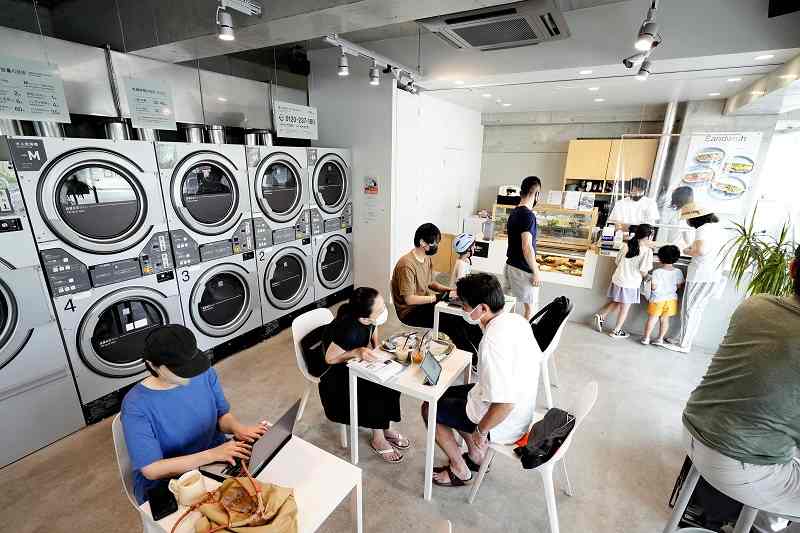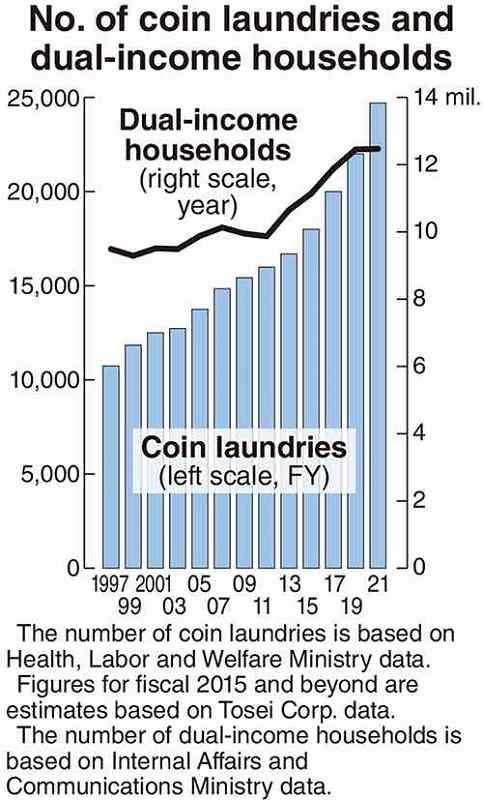Coin laundries evolve to serve women and families

Customers relax at Baluco Laundry Place Yoyogi-Uehara in Shibuya Ward, Tokyo, on Aug. 20.
11:58 JST, September 2, 2022

Coin laundries have been multiplying, especially in urban areas, and many now offer customers not only special washing machines but also a place to relax.
The number of coin laundries has doubled in the past 20 years as more and more dual-income households use them to shorten the time spent on household chores.
With competition now fierce, the laundries are evolving to provide a wider array of services, such as cafes where customers can relax while waiting for their laundry to finish and specialized machines capable of washing sneakers and futons.
Efficient washing
Baluco Laundry Place Yoyogi-Uehara in Shibuya Ward, Tokyo, features its own cafe. Customers are free to visit just to eat or drink, and on weekends the place bustles with families.
“My husband and I both work, and since we have children, I have to run the washing machine many times at home,” said Ayano Takeda, a 45-year-old doctor living in the neighborhood, who visited the coin laundry for the first time on Aug. 20. “I can wash sheets and futon covers all at once here. The atmosphere is cheerful, and it’s nice to be able to spend my time in my own way at the cafe while doing laundry.”
Okulab Inc., a Tokyo-based company that operates Baluco Laundry Place outlets, has six cafe-equipped laundries scattered across Tokyo, Kanagawa Prefecture and other prefectures. One of these laundries, located in the city of Kawasaki, has a sports club, too. “We want people to experience the convenience of doing laundry in a short time, and what it’s like to effectively use one’s waiting time,” an Okulab official said.
Dual-income households
In the past, most coin laundries were used by single men and students, but in the past 10 years, an increasing number of coin laundries have targeted female customers. In addition to laundries with cafes, some coin laundries have located themselves on the premises of shopping centers so that customers can go shopping while waiting.
According to the Health, Labor and Welfare Ministry, there were about 10,000 coin laundries nationwide in fiscal 1997. Last fiscal year, the number is estimated to have exceeded 24,000. Behind this rise is an increase in the number of dual-income households.
“More and more households that are busy with work and child-rearing are washing clothes in batches on weekends to shorten the time for household chores,” said an official of a coin laundry equipment manufacturer.
Multifunctional machines
As their customer base changes, coin laundries are changing their choice of new locations accordingly and transitioning away from public bathhouses, beside which they were traditionally located.
In urban areas, the laundries are now located along busy roads, while in more rural areas, they are opening up in suburbs with large parking lots. In recent years, there have also been cases in which coin laundries have opened in spots abandoned by restaurants due to the novel coronavirus pandemic.
As the number of coin laundries rises, more and more locations are introducing cleaning equipment with functions not available with home-use units.
Many coin laundries are equipped with special machines that are capable of washing bedding such as futons and blankets as well as sneakers and pet mats.
“The number of users has been increasing as people have learned that large items such as futons can be washed [at coin laundries],” said Yuki Maezawa, editor-in-chief of Laundry Business Magazine. “Although the pace of new openings has slowed, the number of users is expected to increase for the time being, especially for those laundries with cafes, which allow customers to make effective use of their laundry time.”




